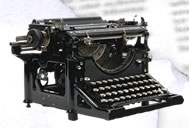By the time this column was read by the American Doughboys, the truce was old news and this STARS AND STRIPES article makes for an interesting read as it imparts much of the November, 1918 excitement that filled the streets of Paris when the news of the Armistice hit the previously gloomy boulevards. This front-page article makes clear that many of the rumors pertaining to the German collapse could not be verified, yet affirms reports concerning the revolution in Germany, it's food shortages and the Kaiser's exile to Holland.
A very moving column from the front page of the November 15, 1918
Stars and Stripes describing the joyous pandemonium that characterized the city of Paris when World War I came to a close:
"And all Paris laughed the laugh of happy children after a day's glad play. And the next day, and the next night, Paris sallied forth to romp and play again."
Click here to read about the W.W. II liberation of Paris.
"St. NAZAIRE, 1918. It was eleven in the morning when we first heard the news. A piercing whistle from one of the steamers in the harbor, a sudden blast so loud and so startling that even the nurses in their rest camp in La Baule fifteen kilometers away could hear it...L'ARMISTICE EST SIGNÉ...by noon the entire town was outdoors; a truck load of German prisoners rolled past, apparently quite as happy as the rest of us."
In the attached 1945 article an anonymous YANK MAGAZINE correspondent describes for his young readers how the last World War ended; the widely reported misinformation of a
premature armistice treaty that was reported as being signed on November 7, 1918 - the retraction, and the subsequent announcement of the genuine armistice being signed four days later. General John J. Pershing recalled the scene in Paris:
"It looked as though the whole population had gone out of their minds. The city turned into pandemonium. The streets and boulevards were packed with people singing and wearing all sorts of odd costumes. The crowds were doing the most clownish things. One could hardly hear his own voice, it was such bedlam."
Click here to read another article describing the Armistice Day celebrations in 1918 Paris.
Click here to read an explanation as to what was understood about the truce of November 11, 1918.
A good nine-panel cartoon that appeared in an American veterans magazine on
the first anniversary of the Armistice.
What is especially amusing is the satirical depiction of German soldiers in the final frame, which fully supports the thesis of Joseph E. Persico's book, Eleventh Month, Eleventh Day, Eleventh Hour that the American Army was on the attack all the way up to the bitter end.
that the American Army was on the attack all the way up to the bitter end.
Attached herein are the terms of the
1918 Armistice as they appeared in the official newspaper of the American Expeditionary Forces:
"The complete official translated text of the Armistice conditions to which the German plenipotentiaries set their signature is herewith reproduced:
1.) Cessations of operations by land and in air six hours after the signature of armistice.
II.)Immediate evacuation of the invaded countries...
etc, etc, etc...
There Are Additional Magazine
Articles About W.W. I
During the pre-dawn hours of November 7, 1918 the German peace delegation crossed through to the American sector at a battle-scared Argonne village named Cunel. A former private in the U.S. Fifth Infantry Division, Amico J. Barone, recalled that night and wrote this essay in 1938.
From our humor department came this submission that first appeared in a British Army Trench magazine.
To mark the 1921 anniversary of Armistice Day, the editors put the word out to all their readers that they wanted to hear from them concerning where they were and what they were doing when they first heard that "la guerre was fini" - they received many answers, from both veterans and civilians alike.
Whether or not this story is true or not, it's a wonderful ride - written in the idiom of the American trench-dwellers of the time. It's awfully funny.
